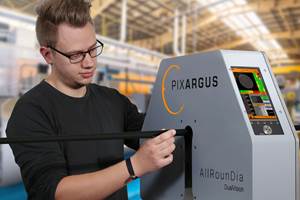On-Line PET Bottle Thickness Gauging Brings Responsive Process Control
Maintaining desired wall thickness in the neck, shoulder, wall, and base of a PET bottle is a continuing challenge to blow molders, says Chris Robinson, head of quality assurance at the Bowling Green, Ohio, plant of Southeastern Container (SEC) Group Inc.
Maintaining desired wall thickness in the neck, shoulder, wall, and base of a PET bottle is a continuing challenge to blow molders, says Chris Robinson, head of quality assurance at the Bowling Green, Ohio, plant of Southeastern Container (SEC) Group Inc. "Most bottle problems are thickness related," says Robinson. A choke neck, pearl feet, or thin sidewall are common areas of concern. "Several variables go into blowing the bottle, including heat, humidity, preform quality, resin quality, and machine set-up," adds Tim Atkinson, maintenance-team coach at the plant. To keep all these variables under control, the molder needs real-time information about the material distribution in the bottles coming out of the machine. But until recently, no system was available to provide such data.
Until the arrival of a dramatically new type of QC instrument, SEC had to be satisfied with off-line checks on sample bottles from each hour's production. SEC cut up the bottles and weighed sections as an indirect measure of wall thickness. That approach did not permit timely adjustments of SEC's Sidel reheat stretch-blow machines, each of which puts out several tens of thousands of bottles per hour. "Any bottle-quality issues could find its way into a whole hour's worth of production," says Robinson. For SEC Group, a seven-plant cooperative that makes PET containers exclusively for Coca-Cola bottlers, product uniformity is critical.
A solution to this problem comes from Agr*TopWave LLC, Butler, Pa., which has introduced the first device for measuring wall-thickness in-line with high-speed PET bottle production. The company's new PETWall instrument checks each and every bottle as it comes out of the molding machine, says David A. Dineff, product marketing director for Agr*TopWave. On a dual-outfeed machine, the device uses two infrared sensors on each outfeed to measure two points on the bottle. With a single outfeed, PETWall can accommodate four sensors for four thickness readings per bottle. Readings are taken within 0.2 sec or less, so the device can handle up to 30,000 bottles/hr per outfeed. Measurement accuracy is said to be 0.001 in.
"The unit can identify process trends before they become production problems, reducing the reaction time for detection, determining the cause, and adjusting the blow molding unit to solve the problems," says Robinson. Operators use the readings from PETWall to adjust heating zones in the molding machine. The system has been commercial since May and is priced under $75,000 depending on system set-up.
Real-time inspection
PETWall consists of an infrared light panel and cylindrical sensing head. The unit measures ir absorption as the light passes horizontally through a section of the bottle. The system's processor translates that information into an average wall-thickness measurement.
The system can measure a bottle with up to 5 in. diam, which corresponds to a typical three-liter bottle. SEC configured its two-liter bottle line so that the output is split into two take-off streams. Each outfeed is set up with two sensor heads that look at the neck and foot of each bottle.
The operator programs the desired wall-thickness control limits into the free-standing operator interface. The flat-panel monitor displays a graphical rendering of the bottle, showing the positions of the sensors taking the measurement. Thickness measurements that are within the preset upper and lower control limits are shown in green. Wall thicknesses that are not as good but still acceptable are indicated in yellow, while unacceptable wall thicknesses are shown in red. That way, the operator gets a quick visual indication of the wall thickness readings from each sensor. The operator knows immediately when to adjust heating zones and also sees right away the results of those process changes. PETWall also provides a one-minute average chart of upper and lower control limits, so that an operator can see if the process is trending out of control. "This is where the system goes beyond inspection and sorting out bad bottles, giving the operator enough information on the product that correlates with what is happening inside the blow molding unit," says Atkinson. Robinson notes that SEC also performs visual checks for bottle defects and contamination at least once every hour.
Since July, SEC has had PETWall systems installed on its machine making two-liter bottles. SEC produces clear and green packages on that line and finds that bottle color makes no difference. The company is now setting PETWall up on a second line that will make 20-oz bottles.
Related Content
Measuring Technology Specialist Pixargus Acquired by CiTex Group
A global player in optical inline quality control, Pixargus is intensifying presence in U.S. & Asia under CiTex umbrella.
Read MoreUpgrade to Accelerated Artificial and Natural Weathering Testing
NPE2024: Atlas S³T system is designed for the company’s Weather-Ometer Ci4400 and Ci5000 instruments.
Read MoreHow to Optimize Color Evaluation of Recycled Plastics
The right color measurement instrument and good working methods will minimize variability in color evaluation of PCR.
Read MoreBrabender GmbH Bought By Austrian Measurement Company
Leading metrology company Anton Paar buys 100-year old firm, known in the U.S. as C.W. Brabender.
Read MoreRead Next
Beyond Prototypes: 8 Ways the Plastics Industry Is Using 3D Printing
Plastics processors are finding applications for 3D printing around the plant and across the supply chain. Here are 8 examples to look for at NPE2024.
Read MoreLead the Conversation, Change the Conversation
Coverage of single-use plastics can be both misleading and demoralizing. Here are 10 tips for changing the perception of the plastics industry at your company and in your community.
Read MorePeople 4.0 – How to Get Buy-In from Your Staff for Industry 4.0 Systems
Implementing a production monitoring system as the foundation of a ‘smart factory’ is about integrating people with new technology as much as it is about integrating machines and computers. Here are tips from a company that has gone through the process.
Read More











